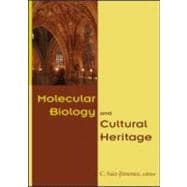
Note: Supplemental materials are not guaranteed with Rental or Used book purchases.
Purchase Benefits
What is included with this book?
| Foreword | |
| Organization | |
| Overview on existing molecular techniques with potential interest in cultural heritage | p. 3 |
| Acidobacteria in Paleolithic painting caves | p. 15 |
| The colonisation of building materials by microorganisms as revealed by culturing and molecular methods | p. 23 |
| Description of novel bacterial species associated with biodeteriorated mural paintings using molecular techniques | p. 29 |
| Analysis of the microbial diversity present on the wall paintings of Castle of Herberstein by molecular techniques | p. 35 |
| Classifying bacterial isolates from hypogean environments: Application of a novel fluorimetric method for the estimation of G + C mol% content in microorganisms by thermal denaturation temperature | p. 47 |
| Fluorescent In Situ Hybridization (FISH) to study biodeterioration in cultural heritage | p. 55 |
| Biocide treatment of rock and mural paintings: Problems of application, molecular techniques of control and environmental hazards | p. 61 |
| Cyanobacteria and biodeterioration of monumental stones | p. 73 |
| Biodeterioration of miniature paintings from the 18th and 19th centuries | p. 79 |
| Microbial contamination in museum collections: Organic materials | p. 85 |
| Microbial toxins in moisture damaged indoor environments and cultural assets | p. 93 |
| Molecular characterization of lead-resistant isolates from Certosa of Pavia red stains | p. 109 |
| Characterization of bacterial communities on stone monuments by molecular biology tools | p. 115 |
| Protein studies in cultural heritage | p. 119 |
| Tiffany's drawings, fungal spots and phylogenetic trees | p. 131 |
| An investigation of bacterial dissolution of Maya limestone: Biodiversity and functional analysis | p. 137 |
| Molecular biology for investigation of cyanobacterial populations on historic buildings in Brazil | p. 141 |
| The potential of DGGE for analysis of fungal biofilms on historic buildings | p. 145 |
| Cyanobacteria attack rocks (CATS): Control and preventive strategies to avoid damage caused by cyanobacteria and associated microorganisms in Roman hypogean monuments | p. 151 |
| Aerophytic biofilms in dim habitats | p. 163 |
| The importance of light in the conservation of hypogean monuments | p. 171 |
| Biomineralisation of different crystalline phases by bacteria isolated from catacombs | p. 179 |
| Multiple approach to study the structure and diversity of microbial communities colonizing artistic surfaces. Study case: The Roman catacombs of St. Callixtus and Domitilla | p. 187 |
| Effect of Algophase on the cyanobacterium Gloeothece membranacea CCAP 1430/3 | p. 195 |
| Biomediated calcite tratments for stone conservation | p. 201 |
| Microbial calcium carbonate precipitation for reinforcement of monumental stones | p. 209 |
| Fungal colonization on treated and untreated stone surfaces | p. 213 |
| Microbial communities in black crusts: An approach for assessing carbon utilisation | p. 219 |
| Insect infestation in museum collections: Organic materials | p. 225 |
| Biodeterioration control in cultural heritage: Methods and products | p. 233 |
| Deterioration and bioremediation of fresco: A case-study | p. 243 |
| Diagnostic tools for monitoring phototrophic biodeteriogens | p. 247 |
| A comparative study on biodeterioration and weathering effects in three sites of the Latin American cultural heritage | p. 253 |
| Microbiological studies of biofilm present on stones from the National Museum building, Bogota, Colombia | p. 259 |
| Experimental evidence of oxalate formation by fungal strains on marble samples | p. 263 |
| The microbial flora of naturally-aged silk fibroin | p. 267 |
| Atmospheric and biological deterioration of two churches of the cultural heritage of the city of Medellin, Colombia | p. 271 |
| Preliminary microbiological analysis of biofilms of some monuments in Villa de Leyva, Colombia | p. 277 |
| Experimental approach of the role of rock varnish in the transfer properties of sandstone | p. 281 |
| Author index | p. 287 |
| Table of Contents provided by Blackwell. All Rights Reserved. |
The New copy of this book will include any supplemental materials advertised. Please check the title of the book to determine if it should include any access cards, study guides, lab manuals, CDs, etc.
The Used, Rental and eBook copies of this book are not guaranteed to include any supplemental materials. Typically, only the book itself is included. This is true even if the title states it includes any access cards, study guides, lab manuals, CDs, etc.